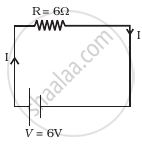Advertisements
Advertisements
Question
Consider the following statements.
(A) Free-electron density is different in different metals.
(B) Free-electron density in a metal depends on temperature.
Peltier Effect is caused _______________ .
Options
due to both A and B
due to A but not due to B
due to B but not due to A
neither due to A nor due to B
Solution
due to A but not due to B
In Peltier Effect, one of the junctions gets heated up and the other cools down when electric current is maintained in a circuit of material consisting of two dissimilar conductors.
This is caused due to the difference in density of free electrons in different metals. When two different metals are joined to form a junction, the electrons tend to diffuse from the side with higher concentration to the side with lower concentration. If current is forced through the junction, positive or negative work is done on the charge carriers, depending on the direction of the current. Accordingly, thermal energy is either produced or absorbed. Thus, Peltier Effect is caused due to A but not due to B.
APPEARS IN
RELATED QUESTIONS
Define the term drift velocity.
What is its relation with relaxation time?
Estimate the average drift speed of conduction electrons in a copper wire of cross-sectional area 1.0 × 10−7 m2 carrying a current of 1.5 A. Assume the density of conduction electrons to be 9 × 1028 m−3
The number density of free electrons in a copper conductor is 8.5 × 1028 m−3. How long does an electron take to drift from one end of a wire 3.0 m long to its other end? The area of cross-section of the wire is 2.0 × 10−6 m2 and it is carrying a current of 3.0 A.
On the basis of electron drift, derive an expression for resistivity of a conductor in terms of number density of free electrons and relaxation time. On what factors does resistivity of a conductor depend?
Why alloys like constantan and manganin are used for making standard resistors?
Define relaxation time of the free electrons drifting in a conductor. How is it related to the drift velocity of free electrons? Use this relation to deduce the expression for the electrical resistivity of the material.
Consider the following statements.
(A) Free-electron density is different in different metals.
(B) Free-electron density in a metal depends on temperature.
Thomson Effect is caused _______________ .
The position-time relation of a particle moving along the x-axis is given by x = a - bt + ct2 where a, band c are positive numbers. The velocity-time graph of the particle is ______.
An electric bulb.is rated 220 v and 100 watt power consumed by it when operated on 'no volt is:-
The identical conductors maintained at same temperature are given potential difference in the ratio 1 : 2. Then the ratio of their drift velocities is ______.
Is the momentum conserved when charge crosses a junction in an electric circuit? Why or why not?
- Consider circuit in figure. How much energy is absorbed by electrons from the initial state of no current (ignore thermal motion) to the state of drift velocity?
- Electrons give up energy at the rate of RI2 per second to the thermal energy. What time scale would one associate with energy in problem (a)? n = no of electron/volume = 1029/m3, length of circuit = 10 cm, cross-section = A = (1mm)2

Define relaxation time.
Derive an expression for resistivity of a conductor in terms of the number density of charge carriers in the conductor and relaxation time.
The potential difference applied across a given conductor is doubled. How will this affect (i) the mobility of electrons and (ii) the current density in the conductor? Justify your answers.
A potential difference (V) is applied across a conductor of length 'L' and cross-sectional area 'A'.
How will the drift velocity of electrons and the current density be affected if another identical conductor of the same material were connected in series with the first conductor? Justify your answers.
Two conductors, made of the same material have equal lengths but different cross-sectional areas A1 and A2 (A1 > A2). They are connected in parallel across a cell. Show that the drift velocities of electrons in two conductors are equal.
